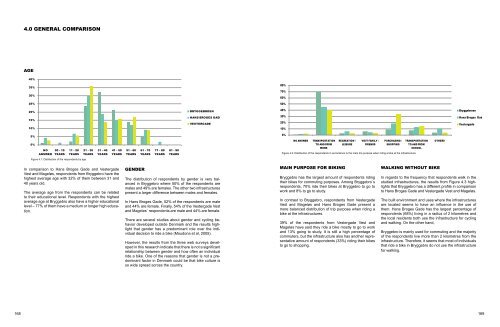Aalborg Universitet Bike Infrastructures Report Silva, Victor ... - VBN
Aalborg Universitet Bike Infrastructures Report Silva, Victor ... - VBN
Aalborg Universitet Bike Infrastructures Report Silva, Victor ... - VBN
You also want an ePaper? Increase the reach of your titles
YUMPU automatically turns print PDFs into web optimized ePapers that Google loves.
4.0 GENERAL COMPARISON<br />
AGE<br />
40%<br />
AGE<br />
MAIN PURPOSE FOR BIKING<br />
35%<br />
30%<br />
80%<br />
70%<br />
60%<br />
25%<br />
50%<br />
20%<br />
15%<br />
10%<br />
BRYGGEBROEN<br />
HANS BROGES GADE<br />
VESTERGADE<br />
40%<br />
30%<br />
20%<br />
10%<br />
Bryggebroen<br />
Hans Broges Gade<br />
Vestergade<br />
5%<br />
0%<br />
0%<br />
NO<br />
ANSWER<br />
00 - 10<br />
YEARS<br />
11 - 20<br />
YEARS<br />
21 - 30<br />
YEARS<br />
31 - 40<br />
YEARS<br />
41 - 50<br />
YEARS<br />
51 - 60<br />
YEARS<br />
61 - 70<br />
YEARS<br />
71 - 80<br />
YEARS<br />
81 - 90<br />
YEARS<br />
NO ANSWER<br />
TRANSPORTATION<br />
TO AND FROM<br />
WORK<br />
RECREATION /<br />
LEISURE<br />
VISIT FAMILY /<br />
FRIENDS<br />
PURCHASING /<br />
SHOPPING<br />
Figure 4.2: Distribution of the respondents in accordance to the main trip purpose when riding a bike at the infrastructure.<br />
TRANSPORTATION<br />
TO AND FROM<br />
SCHOOL<br />
OTHERS<br />
Figure 4.1: Distribution of the respondents by age<br />
In comparison to Hans Broges Gade and Vestergade<br />
Vest and Mageløs, respondents from Bryggebro have the<br />
highest average age with 32% of them between 31 and<br />
40 years old.<br />
The average age from the respondents can be related<br />
to their educational level. Respondents with the highest<br />
average age at Bryggebro also have a higher educational<br />
level – 77% of them have a medium or longer high education.<br />
GENDER<br />
The distribution of respondents by gender is very balanced<br />
in Bryggebro where 50% of the respondents are<br />
males and 49% are females. The other two infrastructures<br />
present a larger difference between males and females.<br />
In Hans Broges Gade, 52% of the respondents are male<br />
and 44% are female. Finally, 54% of the Vestergade Vest<br />
and Mageløs` respondents are male and 44% are female.<br />
There are several studies about gender and cycling behavior<br />
developed outside Denmark and the results highlight<br />
that gender has a predominant role over the individual<br />
decision to ride a bike (Moudona et al, 2005).<br />
However, the results from the three web surveys developed<br />
in this research indicate that there is not a significant<br />
relationship between gender and how often an individual<br />
ride a bike. One of the reasons that gender is not a predominant<br />
factor in Denmark could be that bike culture is<br />
so wide spread across the country.<br />
MAIN PURPOSE FOR BIKING<br />
Bryggebro has the largest amount of respondents riding<br />
their bikes for commuting purposes. Among Bryggebro`s<br />
respondents, 70% ride their bikes at Bryggebro to go to<br />
work and 8% to go to study.<br />
In contrast to Bryggebro, respondents from Vestergade<br />
Vest and Mageløs and Hans Broges Gade present a<br />
more balanced distribution of trip purpose when riding a<br />
bike at the infrastructures.<br />
39% of the respondents from Vestergade Vest and<br />
Mageløs have said they ride a bike mostly to go to work<br />
and 13% going to study. It is still a high percentage of<br />
commuters, but the infrastructure also has another representative<br />
amount of respondents (33%) riding their bikes<br />
to go to shopping.<br />
WALKING WITHOUT BIKE<br />
In regards to the frequency that respondents walk in the<br />
studied infrastructures, the results from Figure 4.3 highlights<br />
that Bryggebro has a different profile in comparison<br />
to Hans Broges Gade and Vestergade Vest and Mageløs.<br />
The built environment and uses where the infrastructures<br />
are located seems to have an influence in the use of<br />
them. Hans Broges Gade has the largest percentage of<br />
respondents (68%) living in a radius of 2 kilometres and<br />
the local residents both use the infrastructure for cycling<br />
and walking. On the other hand,<br />
Bryggebro is mainly used for commuting and the majority<br />
of the respondents live more than 2 kilometres from the<br />
infrastructure. Therefore, it seems that most of individuals<br />
that ride a bike in Bryggebro do not use the infrastructure<br />
for walking.<br />
168 169
















